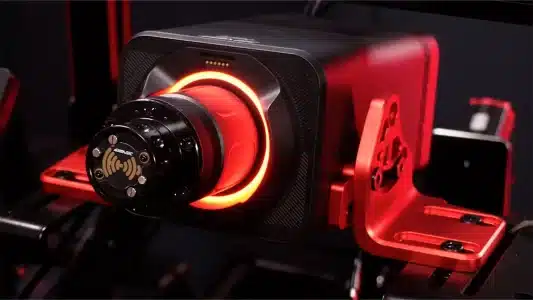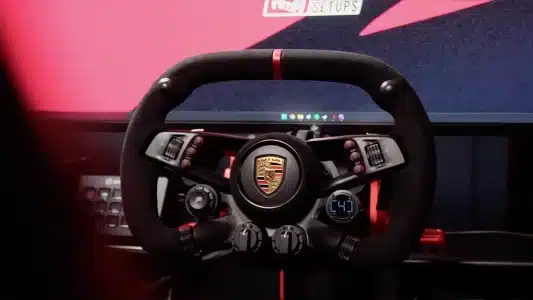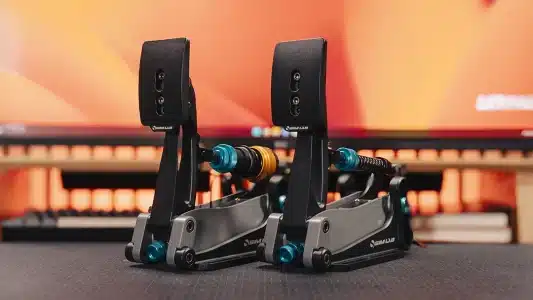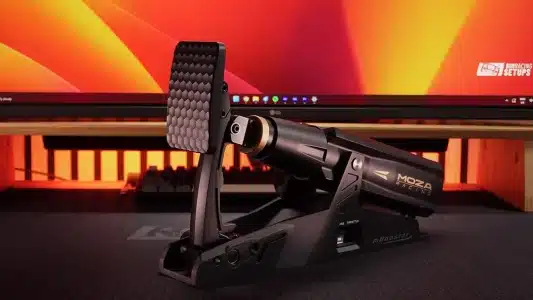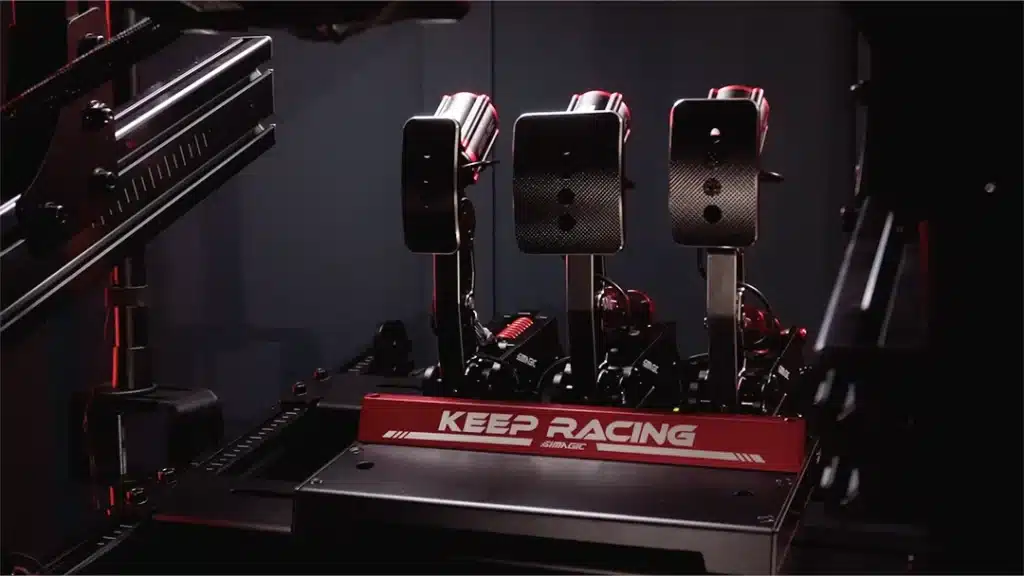
Our Verdict
Pros
- Incredibly smooth and quiet pedal travel.
- Fantastic build quality and premium design.
- Good amount of adjustability.
- First-party haptic modules are excellent.
- SimHub compatible.
- Upgradeable to hydraulic pedals.
Cons
- Slightly soft throttle pedal.
- Adjustments take time.
- Some adjustments are hard to make.
- Moving the throttle or clutch can cover the mounting holes.
There is the P1000, P1000i, P1000-F, P1000-FRS, P1000-RS, and P1000i-RS. And that isn’t even mentioning the optional extras such as hydraulic brake and throttle add-ons and HPR haptic motors.
Well, in this review, I’m going to be putting the P1000 pedals through their paces, and breaking down some of this confusion. SIMAGIC has sent over the P1000 pedals, along with some accessories and upgrades. So let’s jump into our review.
Watch our SIMAGIC P1000 Pedals Review
Video coming soon.
What are the SIMAGIC P1000 Pedals?
In reality, all of the different versions and model numbers for the P1000 pedals, while confusing initially, can be broken down into a few key upgrades that are available.
From a base level, the SIMAGIC P1000 pedals are a two or three pedal set, that offers mid to high end performance. Unless you upgrade to the hydraulic set, you’ll always get a 100kg load cell behind the brake pedal. And, with usual SIMAGIC style, you get a boatload of adjustments that can be made.

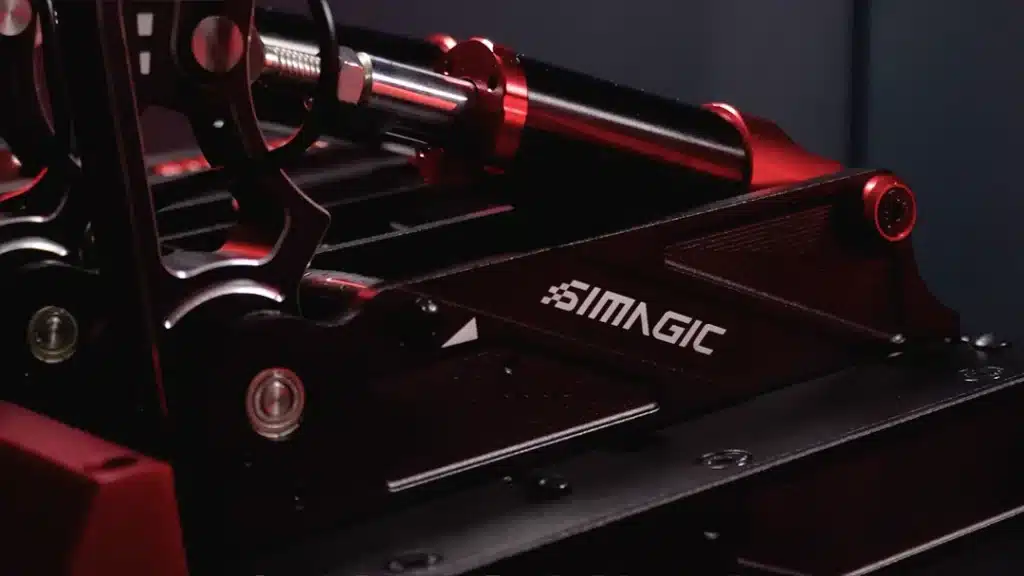
All pedals feature interchangeable elements including springs and elastomers, which affect how the pedal feels. Then you have the upgrades that are available. There are hydraulic brake and throttle mods that transform this mid-range pedal set into a pretty high end beast. And much like the Fanatec Clubsport V3’s, you can also add haptic motors to each pedal.
How much do the P1000 Pedals cost?
Before I delve too far, I want to look at the price for each version of the P1000, and breakdown how each version of pedal is different.
As mentioned at the start of this review, there are a variety of different versions of the P1000. These are signified by different letters at the end of the product name. Fundementaly, there are three varients which can be mixed and matched.
You have the;
- P1000: This is the base spec of the pedal, featuring three pedals, the load cell brake, and not much else. This set will cost you $559, although, at the time of this review, it is on sale at $469.
- P1000 pedals cost $559
- P1000-RS cost $669
- “i” Inverted: If you see an “i” attached to any model name, it means inverted. These pedals include an inverted frame to better imitate a road car.
- The P1000i cost $649
- The P1000i-RS costs $839
- “F” Formula: An F at the end of any model name signifies SIMAGIC’s formula variant. These pedals only include two pedals, removing the clutch to allow for a cheaper price.
- The P1000-F pedals cost $489
- The P1000-FRS cost $629
- “RS” Hydraulic: Finally, you get the RS pedals, which actually stands for hydraulic. I’m not sure why SIMAGIC didn’t follow its own naming convention and call these the “H” pedals. I guess, they wanted something edgier to show that these are the super duper, top of the range versions. Who knows. All versions of the P1000 have an RS version.
- P1000-RS cost $669
- P1000i-RS cost $839
- P1000-FRS cost $629
| Product | Price |
|---|---|
| SIMAGIC P1000 | $559 |
| SIMAGIC P1000-RS | $669 |
| SIMAGIC P1000-F | $489 |
| SIMAGIC P1000-FRS | $629 |
| SIMAGIC P1000i | $649 |
| SIMAGIC P1000i-RS | $839 |
There are also a range of accessories for the P1000 which can be purchased individually of the actual pedals themselves. These include the haptic motors which I am running three of. These start at $80 per haptic motor and can be bundled as a pair or as three motors to save some money.
You can also upgrade your throttle and brake to a full hydraulic system that is found on the P1000-RS at any point. This is a great upgrade path if you start with the P1000’s and then want to upgrade over time. And this is something that all pedal manufacturers should consider doing to avoid the cost of buying a whole new pedal set to upgrade.
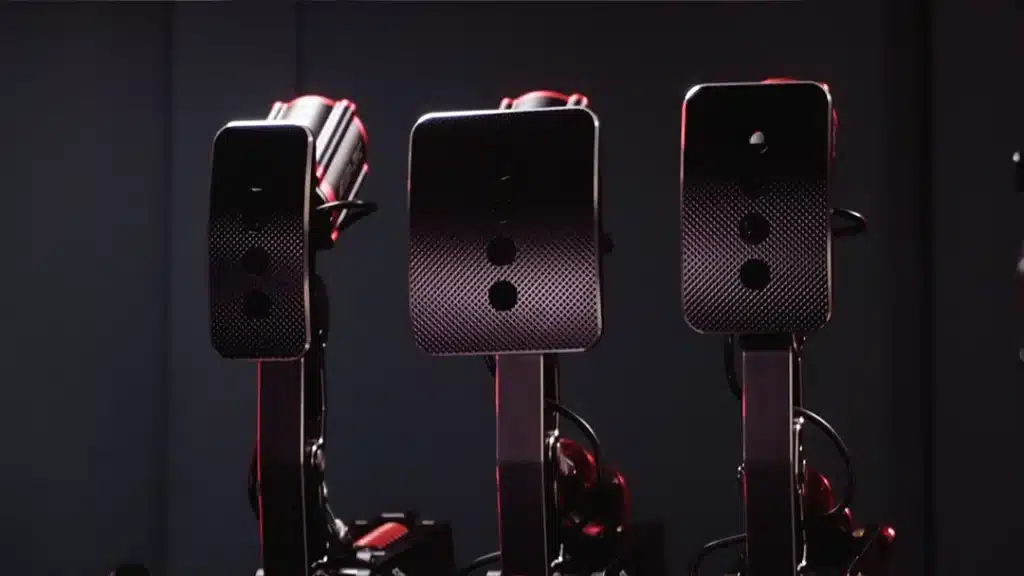
These hydraulic upgrades cost $139 for the throttle, and $179 for the brake, so they aren’t especially cheap. However, compared to the cost of buying a whole new pedal set, these are excellent value, and the perfect way to upgrade over time.
If you have the P1000 pedals but like the look of Asetek’s LED light integration with their Forte and Invicta pedals, you can add some pizazz to the P1000 thanks to the Sim Ray-Heel Stop. This $79 accessory adds a little more flair to your pedal set.
| Product | Price |
|---|---|
| HPR Bundle | $80 |
| P-HTS (Hydraulic Throttle) | $139 |
| P-HYS (Hydraulic Damper) | $179 |
| P-ORP (Additional Springs & Dampers) | $19.90 |
| Sim Ray-Heel Stop | $79 |
How does this price compare to the competition?
Starting at $489 for the 2 pedal P1000-F pedals, the price seems to me to be very competitive. They are more expensive than the Fanatec Clubsport V3’s, and a little more than the MOZA CRP2 in its two pedal configuration. However, the P1000’s are providing a platform for you to build upon, with so many upgrades available. And this is something that few other direct competitors offer.
| Pedals | Price | Difference |
|---|---|---|
| Fanatec ClubSport V3 | $329.95 | – $229.05 |
| MOZA CRP2 | $399.00 | – $160.00 |
| Asetek Forte | $459.99 | – $99.01 |
| P1000-F | $489.00 | – $70.00 |
| Sim-Lab XP-1 (With heel rest & baseplate) | $538.00 | – $21.00 |
| P1000 | $559.00 | |
| Heusinkveld Sprint (2 Pedals) | $589.00 | + $30.00 |
Unboxing and what’s included
When you first open the box, you’re presented with some funky looking stickers, something a bit out of the ordinary which I like. The first box houses all of the cables, mounting hardware and some additional springs. You also get a paper quick start guide which is actually pretty detailed, highlighting how to make all adjustments.
There is a heel rest included, something that wasn’t included on the Sim-Lab XP-1 Pedals that I recently reviewed. There are some additional dampers for the brake included and I’ve got the extra spring and damper set which is priced around $20.
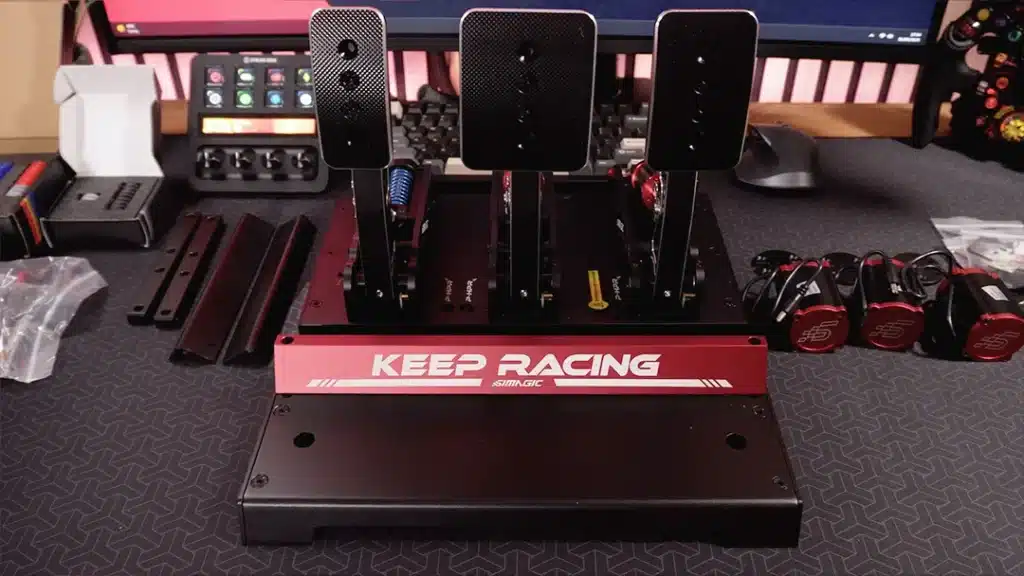
There are also a set of mounting adapters included which essentially provide more mounting points which I always love.
I have opted for three of the haptic motors, each individually packaged. Thanks to their all-metal construction, these motors feel incredibly high-quality. If you’re opting for the haptic motors or the LED heel stop, you will require a PSU that is boxed individually.
Finally, we have the pedals themselves, which come pre-built other than the heel rest. The heel rest bolts on the front using two adjoining adapters.
The design & build quality
While unboxing everything, my first thought was just how high-quality all the components are. Everything from the entire pedal setup to the heel rest and even the haptic motor modules are built from metal, with a CNC-milled aluminium housing.
The overall quality is incredibly high and really goes a long way to justify the price. The design is top-notch too with a combination of black, silver and red contrasts throughout. This is an extremely pretty pedal set, and one that fits perfectly with our black and red brand and the red on my Next Level Racing sim rig.
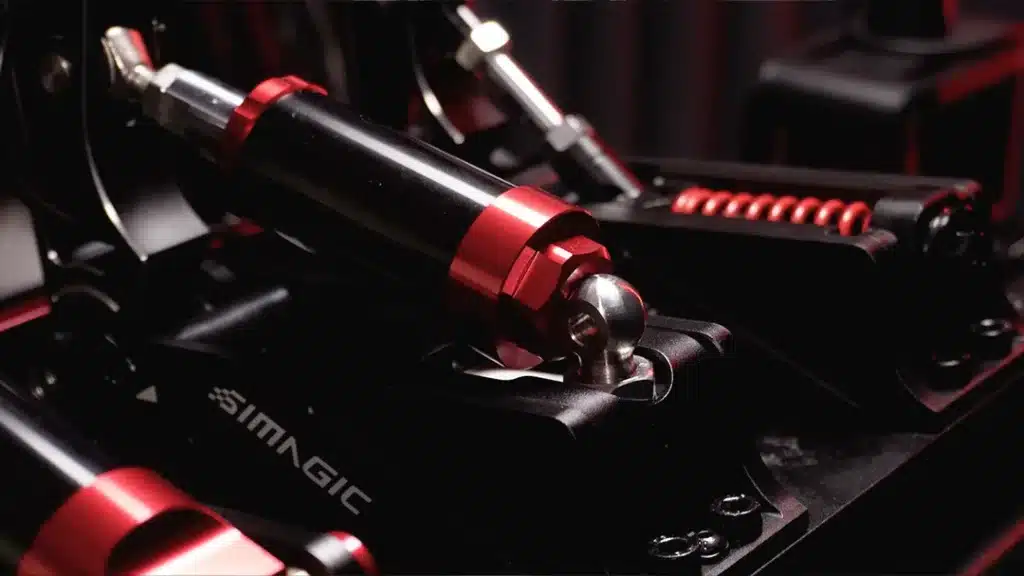
SIMAGIC have also thought about small areas that matter to many sim racers. The cable management is all handled really well and hidden under the baseplate. There are even 3M cable clips that let you neatly contain the cables from the haptic motors.
Internally, all three pedals use a contactless Hall effect sensor, which ensures no loss of quality or input sensitivity over time. The brake also includes a load cell sensor rated upto 100kg, and you can switch between the load cell and the hall effect sensor at any time.
Adjustability
Adjustability within sim racing is arguably the most important when it comes to pedals. Finding the sweet spot can let you feel much more comfortable and get into your groove on track. SIMAGIC knows this and has worked a tonne of adjustability into almost all areas of each pedal.
Starting with the pedal’s position on the baseplate, the additional mounting holes allow each pedal to be moved slightly on the base itself. The first issue does crop up when doing this, though. If you move either the throttle or clutch pedal, you can accidentally cover the mounting point on the base. You can still mount the pedals using the side adapters, or move the pedal after mounting. However, this clash in mounting does feel like a small issue that could have been avoided.
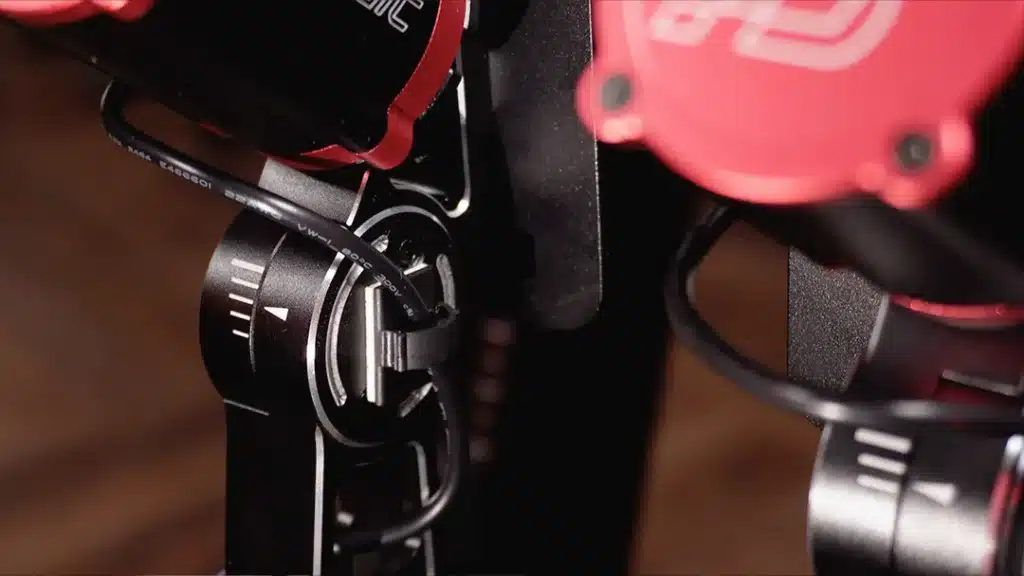
Moving on, you get the usual adjustment points that include the angle and height of the face plate, and the pedal travel. You also get two hinge points for the throttle pedal which affect the overall stiffness and resistance of your throttle input.
Then you get a huge array of adjustment over the internal mechanisms of all pedals. Both the clutch and throttle pedals have replaceable springs, while the brake has an almost unlimited amount of variation thanks to the combination of damping blocks and springs.
Using the included dampers, and the optional brake dampers, you can emulate the brake feel from a range of cars such as formula or GT cars, through to road cars. SIMAGIC have a variety of recommendations if you aren’t sure what configuration to go for, but ultimately, the decision is yours.
I have to say the ease of adjustments for changing the internal parts of each pedal isn’t the easiest. You do have to loosen off the whole pedal arm for the throttle and brake adjustments, which requires the use of tools and a fair bit of force on some occasions.
The clutch pedal can also be hard to replace the spring as you have to push the whole mechanism in before releasing the pedal arm. Small difficulties such as these make me think twice about making mechanical adjustments.

This process certainly isn’t as easy as it is with the Sim-Lab XP-1 pedals that I switched from, and I would marginally say that the MOZA CRP2 pedals are quicker to replace the dampers than with the P1000.
Software
Beyond the mechanical adjustments, you do get a good amount of software adjustment. You can change the input curve of each pedal, the deadzone and the force required for the load cell brake. This is all pretty standard across load cell pedals, and SIMAGIC does a nice way of presenting all of this information.
You do get more control over the haptic motors, and the interface isn’t too dissimilar to active pedals such as the mBooster. You can enable specific effects for each pedal, and then you can jump in and change the strength and frequency of the haptics.
This fine level of control lets you create some unique combinations, such as having the ABS trigger faint rumbles, while a wheel lock up shakes the brake pedal a lot harder. You can also delve into SimHub to control these haptics which is useful if you’re already utilising SimHub for other parts of your sim racing setup.
Once you’re happy with your settings, you can save a preset and assign a good number of filters to it. This preset system is really neat, letting you easily filter through various presets for different games and cars.
Mounting the pedals
Mounting the pedals is extremely easy, with a fair bit of control. There are four pre-drilled mounting holes letting you mount the pedals top down. However, these holes can be restrictive if your pedal plate doesn’t have exact holes to mount into.
This is where the two extra mounting blocks come in. These attach to the side of the pedals and provide slot gaps to mount through. Using these can open up more positional adjustment over the placement of your pedals on your rig. I didn’t need them on my highly adjustable Next Level Racing rig, but they’d come in very handy on other sim rigs and cockpits.

Performance review
With the pedals mounted, let’s see how they perform. Starting with the throttle, the input feels incredibly smooth, which is ultimately what you want from a throttle. Unlike other throttle pedals, the input is also incredibly quiet, which is a testament to SIMAGIC’s overall quality.
The resistance on the throttle is on the softer side, and even with the stiffer spring, I would say it’s softer than other pedals. This wasn’t an issue for me, as I felt incredibly comfortable overall with the throttle but it is something worth noting if you like a really stiff throttle.

I’m not one who often uses a clutch pedal, other than when I jump into a sim like AC Evo for a fun blast around in a road car. The way the clutch is designed is to create a very distinctive bit point. As you press on the pedal, it will go light just after halfway which feels pretty realistic.
The stiffness of the clutch felt good, being a little stiffer initially than the throttle. Again, you can change the spring for a stiffer or softer feel, and you can also adjust the pedal resistance directly at the rear.
Next up, the brake pedal. This is the area where a good pedal set can differentiate itself from an average set. And I’m happy to report that the P1000 falls comfortably into the good category.
Using the configuration of elastomers that I settled on, the brake doesn’t have a whole lot of travel. The resistance is firm enough that I had to apply a good amount of pressure to reach the maximum pedal input. This felt very comfortable to me, with the pedal falling on the medium to stiff side.
If you’re one who likes a softer brake pedal, this can absolutely be achieved by swapping out the red and blue elastomers, and opting for the black or grey ones. There are also springs included which, in combination with elastomers, can provide a two stage braking feel.

I tried a few variations of brake dampers, but ended up using the simple red and blue configuration, which is designed to replicate a GT3 car. These are the two stiffest dampers, and with the stiffer setup that I have opted for, I had absolute confidence under braking, and notably when managing the brake input while trailing off the pedal.
P-HPR Haptic motors
While the mechanical feel of every pedal is really damn decent, the additional haptics really elevate the P1000s. I have the motors attached to each pedal, although you can buy just one or two if you didn’t require a whole set.
Fanatec was one of the first to do pedal haptics with their ClubSport V3’s, but the spotlight has really been on active pedals in the past year or so. While these haptics can’t get close to the full experience of an active pedal, they certainly add to the overall gameplay and immersion.
Within the SimPro software, you can configure a range of different effects for each pedal. After playing with the wheel lockup and wheel slip effects, I settled with a simple configuration of just the ABS on the brake and traction control on the throttle.
This let me focus on ensuring I didn’t heavily lean on these assists during my time GT racing. The haptics themselves feel great, although they can feel quite heavy-handed if you dial the strength up too high. With the overall output set to around 50% or lower, the haptics were powerful enough to add immersion, while not overpowering or shaking your pedals too hard.
The whole pedal set really came alive with the haptics integrated. While you can add haptics to almost any pedal set using mods like those available from 3DRap. Having dedicated first-party haptic modules available allows these pedals to stand above many others.
Are the SIMAGIC P1000 Pedals worth buying?
And that is really where SIMAGIC excels with these pedals and their other sim racing hardware lineup. They always seem to go above and beyond many other hardware manufacturers. I felt the same when reviewing the NeoX Hub, which offered almost endless customisation.
A great example of this is the shifter kit, which came packed with a variety of different shifter materials, sizes, and styles, all for around $50. This value and modularity really extends throughout the entire SIMAGIC ecosystem.


The SIMAGIC P1000 pedals may seem expensive initially, with a price comparable to pedals from Sim-Lab and Asetek, and not too far off Heusinkveld prices. However, the incredibly high build quality, the huge amounts of customisation, and the upgrade paths available really justify this.
With a few upgrades, this pedal set can transform into a full, top-of-the-line hydraulic set, saving you hundreds compared to selling and re-investing in a brand new pedal set. The only real downsides of these pedals are the slightly soft throttle and clutch springs, and the small difficulties I faced when making physcial adjustments.
Overall, this is a hugely impressive load cell pedal set, that offers fantastic performance, adjustability and dare I say it value. I wouldn’t hesitate to recommend these, and if I were thinking long term, taking a set of these, which I know can accommodate hydraulic upgrades in the future should I need it, is almost a no brainer.
Frequently asked questions
There are a range of upgrade modules for the P1000. These include haptic motors as well as hydraulic cylinders for the throttle and brake pedals.
You can get the P1000 in a few variations. These include the P1000-F which are a two pedal formula set. There is the P1000i which is an inverted version, and the P1000RS use hydraulic. cylinders.
Technical Specifications
Review written by Felix König










